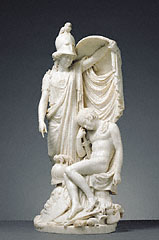• Who do you think the female figure is? What is she doing? What idea might she represent?
(The female figure is the mother of the boy and wife of the man depicted on the
medallion at her feet. She is dressed in the costume of
Minerva, Roman goddess of war and wisdom. She protects her son with one hand,
shielding his naked body, while she points to her husband's portrait with the other. She represents strength
and wisdom, but also duty, loyalty, and virtue.)
• The artist has transformed marble into a representation of many different materials and textures. Find and
describe some of the areas where the marble looks like something other than stone. (Soft thick clouds, smooth skin,
crisp cloth, fluffy feathers, wavy hair.)
• Where is the father in this unique family portrait? (His portrait can be seen in
relief on the medallion at the woman's feet.)
• In art-historical tradition, medallion portraits were often used to signify that someone was no longer alive.
However, we know that Monsieur van Risamburgh was alive when this portrait was made. What other meaning could the
medallion portrait have in this work? (Perhaps that he was absent from the family. The many attributes (or symbols) of war suggest that he might have been fighting for his country.)
• Why do you think the artist chose to portray the son without clothes and sleeping in this sculpture? (The son is
vulnerable, as he is unprotected by clothing, but has complete faith in the strength of his mother and so can sleep soundly.)
• How did the artist include the larger context of the war that was taking place at the time the sculpture was made?
(Through the many attributes of war that can be found in this work, including the pile of weapons; the sword on which the
son rests; the reference to Minerva, with her helmet and shield; and the Roman soldier's helmet above the medallion.) |
Carved from a single block of white marble, this commemorative portrait makes a powerful statement about family and the role of
the mother as protector in the face of an absent father. Monsieur van Risamburgh commissioned Joseph Chinard to create this
sculpture for likely display in a domestic interior.
Madame van Risamburgh, dressed as Minerva, raises her shield and drapery as a canopy over her slumbering son as she stands
on a cluster of billowing clouds. Her naked child is improbably perched on a pile of military equipment and holds in his right
hand a sword or dagger that is clearly too large for him. Monsieur van Risamburgh, a prominent Lyon merchant, is represented in a
medallion portrait on a shield. The medallion rests between the two figures and is topped with an ancient Roman-style plumed helmet.
The medallion format was traditionally used for
Baroque tomb monuments. Chinard repurposed this format to show that, although still
living, Monsieur van Risamburgh is absent from the family.
Through the use of
allegory, Chinard suggested that Madame van Risamburgh was protecting her vulnerable son from current civil and
military unrest while her husband was away, possibly engaged in military or civic duties. A popular Neoclassical sculptor, Chinard
drew on ancient mythology and used
classical forms but imbued the work with a contemporary emotional feeling, celebrating family
and the matriarch as the source of domestic stability.
About the Artist
Joseph Chinard, 1756–1813
French
In a biography of Joseph Chinard, read to the Academy of Lyon a year after his death in 1813, a local historian reported that the
French sculptor's first attempts at art were confections made for the local bakers and candy makers in Lyon. Whether this legend is
true or not, it speaks to the qualities of intimacy, delicacy, and refinement for which Chinard's work was so admired. He received
his first formal training at a free, government-supported art school in Lyon and later studied in a workshop. From 1784 to 1787 he
worked in Rome, sending back to Lyon copies of
antique works to fulfill commissions from the local bourgeoisie and nobility.
During this period he won the first prize in sculpture from the Italian Accademia di San Luca, a rare accomplishment for a
foreigner.
Despite several run-ins with Italian Church authorities for seemingly inappropriate and subversive French Revolutionary imagery
in his sculptures, Chinard continued to travel back and forth between Lyon and Italy. Although one of the most popular French
Empire sculptors and one of the favorite sculptors of Emperor Napoleon's family, Chinard made only three trips to Paris. He
preferred living a provincial life. Nevertheless, his patrons appreciated the sophisticated elegance and charm he gave to his
Neoclassical portrait
busts and allegorical groups.
|

